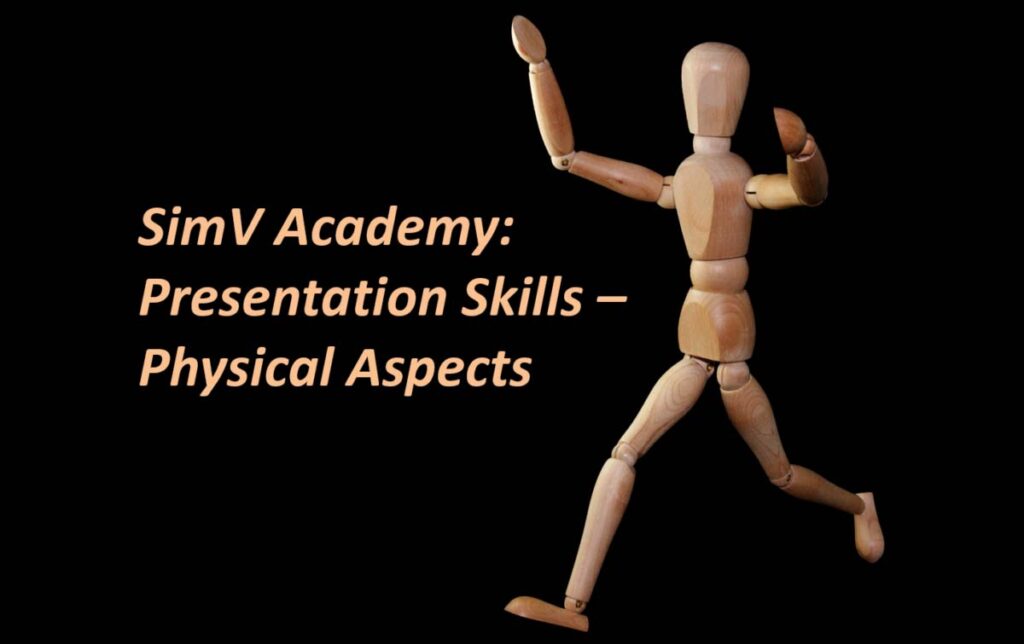By Kat Groves and Taylor Duffy
Did you know that approximately 93% of messages are interpreted by vocal and visual signs, rather than verbal communication? This means that how you say something, and how you look or what you are doing while you are saying it, is exponentially more important than what you say.
Recently, the SimV Academy presented the second class of the presentation skills series, “Physical Aspects of Presentations,” with instructor Katherine Groves. It is very common to be concerned with only the content when preparing for a presentation. This class showed participants the importance of how non-verbal communication can impact the message being presented and gave tips and advice on what body language to focus on, in order to add credence to a presentation while creating trust, clarity, and interest with the audience.
There are 6 categories that make up non-verbal communication. Each category is equally important, as they all work together to create the message you want (or don’t want) to get across.
- Facial Aspects – Your face will say something before your mouth ever does. It can be hard for your face not to show what you are really thinking on the inside, so become aware of what it is doing as you speak. If you do not, you may become a victim of a face that contradicts the message coming out of your mouth. Some examples of facial aspects to consider are eye contact, eyebrow movements, and smiling/frowning. When controlled, it can be a great asset to your presentations by conveying your emotions, creating interest, and complementing the content you share.
- Paralinguistic – These are aspects of spoken communication that do not involve words. Tone of voice, speed and breathing, pronunciation, articulation, pauses, and punctuation are a few examples of paralinguistic communication. Breathing techniques can be used to help calm nerves while presenting. Look them up online or YouTube and practice. You may even think about joining a meditation or yoga community (such as the yoga class SimV Fit has every Tuesdays and Thursdays at noon). Paralinguistic communication can also be used in presentations to add emphasis, give meaning to words, and create emotions in the audience.
- Posture/Body Language – This is the position of your spine and strategically changing your location to connect your message with the audience. Posture, stance, pace, and personal space all fit into this category. Use this communication in your presentations to convey openness, feelings of confidence, and comfort. Remember to stand up straight!
- Personal Space – Closely related to body language, spatial awareness affects control and interest of your audience. You can use proximity to your audience to control those all-so common side-bar conversations. Have you ever been in a presentation or class where the instructor came right up next to you? It can definitely get your attention! Movement toward your audience while listening to and answering questions will convey interest in your audience and what they have to say. By walking toward the audience, you are showing them you want to engage with them. But be careful – it can also create an uncomfortable environment when you put yourself in someone’s personal space.
- Gestures – This communication is moving part of your body, usually your head or hands, to express and emphasize an idea. This includes pointing at a slide, holding up a number in conjunction with a number displayed on the presentation, nodding, and using your hands to mimic your words, such as conveying size. This is helpful for adding emphasis, repeating, showing clarity, and directing attention in your presentations.
- Appearance – Like it or not, first impressions matter! This consists of physical traits and features you notice about someone before they ever speak. Clothes, hair, shoes, and make-up all fit into this category. Your appearance can support the presentation by showing credibility, demonstrating you care, and building trust. As the saying goes – Dress for the job you want, not the job you have! But in this case, dress for the impression you want to make! Until you have the reputation of Steve Jobs, don’t wear flip flops and shorts (unless you are speaking to a bunch of surfers – then it might make sense!)
The key to any presentation is practice, practice, practice! This includes deciding how you want to use your voice to emphasize your point, looking your audience in the eyes, smiling, and using gestures that will complement your words. The above practices in non-verbal communication will help to build trust with your audience, give clarity to your words, and add interest in your message. Grab a mirror! Grab a friend or family member. Practice your presentation to include what points you want to emphasize and how you can use your body and voice to do this. And when it is time, you will give a smooth and clear presentation that keeps everyone engaged and allows your message to be received with enthusiasm.
About SimVentions, Inc.
SimVentions’ corporate office is located at 100 Riverside Pkwy, Suite 123, in Fredericksburg, Virginia, 22406. SimVentions is a 100% employee owned defense contractor focused on developing, integrating, and transitioning new technology to our country’s warfighters. For additional information about SimVentions, please visit https://www.simventions.com/.
SimVentions is always looking for qualified candidates across all disciplines to work in the Fredericksburg, VA; Dahlgren, VA; Washington, D.C.; Charleston, SC; and Virginia Beach, VA areas. Apply online at https://www.simventions.com/careers.
